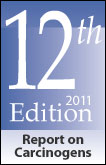US Dept of Health and Human Services report identifies tungsten carbide-cobalt as carcinogen
July 8, 2011
Tungsten carbide-cobalt powders are key ingredients in the manufacture of hardmetal (cemented carbide) cutting and grinding tools, dies, and wear resistant products used in a broad spectrum of industries. Some 56,000 tonnes of WC-Co based products were produced globally in 2008. The US Department of Health & Human Services recently published (on June 11, 2011) its latest ‘12th Report on Carcinogens’ which now includes WC-Co in powder or sintered form as one of 240 substances that may put people at increased risk for cancer.
The complete list and report is available at ntp.niehs.nih.gov/go/roc12 including the 180 page background document and the 6 page substance profile on the reasoning behind classification of WC-Co.
“Reducing exposure to cancer-causing agents is something we all want, and the latest Report on Carcinogens provides important information on substances that pose a cancer risk,” said Dr Linda Birnbaum, director of both the National Institute of Environmental Health Sciences (NIEHS) and the National Toxicology Program (NTP) which compiled the report for the US Dept of Health & Human Services.
It was pointed out that the report identifies agents, substances, mixtures, or exposures in two categories: (1) those known to be a human carcinogen and (2) those reasonably anticipated to be a human carcinogen into which category WC-Co now falls in the USA. The NTP stated that a listing in the ‘Report on Carcinogens’ does not by itself mean that a substance will cause cancer. Many factors, including the amount and duration of exposure, and an individual’s susceptibility to a substance, affect whether a person will develop cancer.
The NTP used established criteria to evaluate the scientific evidence on each candidate substance under review. The NTP also drew upon the scientific expertise of several federal agencies, including the National Institutes of Health, Centers for Disease Control and Prevention, Agency for Toxic Substances and Disease Registry, U.S. Food and Drug Administration, U.S. Environmental Protection Agency, U.S. Consumer Product Safety Commission, and Occupational Safety and Health Administration. “The strength of this report lies in the rigorous scientific review process,” said Dr Ruth Lunn, director of the NTP Office of the Report on Carcinogens. “We could not have completed this report without the significant input we received from the public, industry, academia, and other government agencies.”
In its study of cobalt-tungsten carbide in both powder and sintered form, the Report covers both limited epidemiological evidence of carcogenicity from studies in humans, and also some supporting evidence from studies on mechanisms of carcinogenesis for WC-Co.
It was stated in the report that whilst the reasons for cobalt–tungsten carbide causing cancer have not been fully elucidated, it has been shown that (1) cobalt–tungsten carbide re¬leases cobalt ions, (2) cobalt ions affect biochemical pathways related to carcinogenicity, (3) cobalt compounds are carcinogenic in exper¬imental animals, (4) cobalt–tungsten carbide increases the produc¬tion of reactive oxygen species (ROS) and causes greater cytotoxic, toxic, and genotoxic effects than does cobalt alone, (5) cobalt–tung¬sten carbide causes key events related to carcinogenesis, including genotoxicity, cytotoxicity, inflammation, and apoptosis (programmed cell death), and (6) the oxidative stress response resulting from in-creased ROS production may play a role in these key events and may also interfere with cells’ ability to repair damage caused by cobalt–tungsten carbide.
The combination of the effects from cobalt ions and the oxidative stress response from ROS production were said to provide plausible modes of action for the carcinogenicity of cobalt–tungsten carbide. These findings are reportedly disputed by the various trade bodies representing the companies involved in WC-Co production.
The report also gives details on the major sources of exposure to WC-Co powders and sintered WC-Co materials – which are said to be mainly occupational in the manufacture of products from powder. Information on exposure from end-use of sintered hardmetal tools is said to be limited, and exposure therefore appears to be minimal.
News | Articles | Market reviews | Search directory | Subscribe to e-newsletter
















